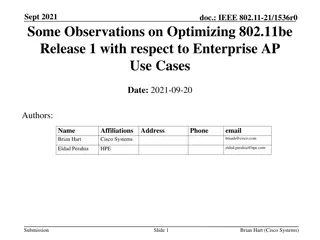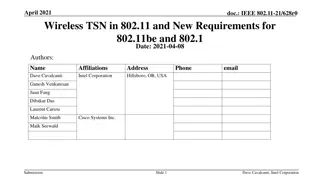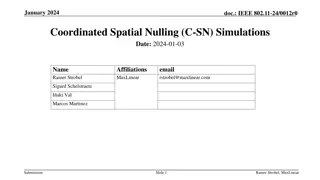Coordinated AP Time/Frequency Sharing in IEEE 802.11be
The document discusses Coordinated AP (CAP) Time/Frequency Sharing in Transmit Opportunity in IEEE 802.11be, focusing on Frequency and Time resource sharing between multiple APs in close proximity. It introduces concepts like CAP OFDMA and CAP TDMA, outlining the benefits in terms of latency improvement and throughput fairness. The assumptions and implications for CAP OFDMA/TDMA deployment are also highlighted.
Uploaded on Jul 18, 2024 | 0 Views
Download Presentation

Please find below an Image/Link to download the presentation.
The content on the website is provided AS IS for your information and personal use only. It may not be sold, licensed, or shared on other websites without obtaining consent from the author. Download presentation by click this link. If you encounter any issues during the download, it is possible that the publisher has removed the file from their server.
E N D
Presentation Transcript
Nov 2019 doc.: IEEE 802.11-19/1582r2 Coordinated AP Time/Frequency Sharing in a Transmit Opportunity in 11be Date: Jan 2020 Name Affiliation Address Phone Email Lochan Verma lverma@qti.qualcomm.com George Cherian Qualcomm Inc. Menzo Wentink Submission Slide 1 Lochan Verma (Qualcomm), et. al.,
Nov 2019 doc.: IEEE 802.11-19/1582r2 Introduction Multiple APs in vicinity of each other can coordinate and share between themselves their time/frequency resource within a TXOP Frequency resource sharing i.e., CAP (Coordinated AP) OFDMA is a procedure wherein an AP that wins the medium access partitions its entire frequency resource and shares the smaller frequency chunks with its neighbor APs for the duration of the TXOP Time resource sharing i.e., CAP TDMA is a procedure wherein an AP that wins the medium access partitions the duration of TXOP and shares its entire frequency resource for the small TXOP duration chunks with its neighbor APs Intuitive gains: worst case-latency improvement; throughput fairness Outline Concept introduction Assumptions Transmission sequence Submission Slide 2 Lochan Verma (Qualcomm), et. al.,
Nov 2019 doc.: IEEE 802.11-19/1582r2 Introduction: CAP OFDMA Compared to EDCA, in CAP OFDMA the TXOP Owner (AP that wins the medium access) shares smaller frequency resource chunks with other APs for the entire TXOP duration within the TXOP E.g., below shows 4 APs, each with 80MHz BW Time EDCA AP1,AP2,AP3,AP4 transmissions maintain orthogonality CAP OFDMA AP1 AP2 AP3 AP4 TXOP TXOP Frequency 80MHz 20MHz Submission Slide 3 Lochan Verma (Qualcomm), et. al.,
Nov 2019 doc.: IEEE 802.11-19/1582r2 Introduction: CAP TDMA Compared to EDCA, in CAP TDMA the TXOP Owner shares entire frequency resource for the small TXOP duration chunks with other APs within the TXOP E.g., below shows 4 APs, each with 80MHz BW AP1 Time AP2 EDCA CAP TDMA AP3 AP4 TXOP 80MHz Frequency 80MHz Submission Slide 4 Lochan Verma (Qualcomm), et. al.,
Nov 2019 doc.: IEEE 802.11-19/1582r2 Assumptions for CAP OFDMA/TDMA All APs in a CAP TX belong to the same ESS An AP does not manage OBSS STAs APs participating in a CAP TX are in range of each other APs participating in a CAP TX not required to have the same P20 No pre-assigned Master AP or pre-assigned AP groups Does not preclude a Master AP, if a deployment chooses to TXOP Owner orchestrates the time/frequency sharing in a TXOP TXOP Owner in CAP OFDMA shares its frequency resource in multiples of 20MHz channels with other participating APs No backhaul coordination between APs assumed, but over-the-air coordination Does not preclude backhaul coordination, if a deployment chooses to Submission Slide 5 Lochan Verma (Qualcomm), et. al.,
Nov 2019 doc.: IEEE 802.11-19/1582r2 An example of CAP TX Phases TXOP Owner orchestrates the time/frequency sharing in a TXOP TX Ind & Req (Indication and Request) Neighboring APs learn of TXOP gained by TXOP Owner (Indication) TXOP Owner learns of neighboring AP s intent to participate in a CAP TX (Request) Schedule Allocation TXOP Owner tells participating APs their allocated subchannels, allocated TXOP duration, and TX start time Participating APs can tell their clients the allocated subchannels, allocated TXOP duration, and TX start time Data TX Participating APs transmit on their respective allocated subchannels for the allocated TXOP duration beginning at the TX start time TX Ind & Req Sched ule Alloc Data TX TXOP Duration Submission Slide 6 Lochan Verma (Qualcomm), et. al.,
Nov 2019 TX Ind & Req Phase and Schedule Alloc Phase doc.: IEEE 802.11-19/1582r2 CTI & CTAS are non-HT DUP Trigger frame variant APs in vicinity not required to be on the same P20 CTR uses TB PPDU; transmitted by the APs in the vicinity of TXOP Owner APs that are dst of CTAS, transmit CTLS that is non-HT DUP frame CTI-CTR and CTAS-CTLS are SIFS interval separated TXOP Duration TX Ind & Req Schedule Alloc CTI CTAS CTLS TXOP Owner (AP1) CTI: CAP TXOP Indication frame CTR: CAP TXOP Request frame CTAS: CAP TXOP AP Schedule frame CTLS: CAP TXOP Local Schedule frame CTR CTLS AP2 CTR CTLS AP3 CTR CTLS AP4 Submission Slide 7 Lochan Verma (Qualcomm), et. al.,
Nov 2019 doc.: IEEE 802.11-19/1582r2 More on Frames in Schedule Alloc CTAS frame: non-HT DUP Trigger frame variant Carries mapping for APID to subchannel, allocated TXOP duration, and TX start time APID can be MAC Addr (BSSID) CTLS: Indicate subchannel allocation, allocated TXOP duration, and TX start time to respective BSSs Use non-HT DUP PPDU TA set to Special (predefined) value of (Multicast) MAC addr RA: Broadcast Doesn t require all participating APs on the same P20 Payload contains IE(s) indicating mapping for APID (i.e., BSSID) to subchannel mapping, allocated TXOP duration, and TX start time Submission Slide 8 Lochan Verma (Qualcomm), et. al.,
Nov 2019 doc.: IEEE 802.11-19/1582r2 Data TX in CAP OFDMA TXOP Owner and participating APs transmit on their respective BW chunks Each sync FDMA TX composed of OFDMA for different users of that AP Sync FDMA here implies that each of the AP1, AP2, and AP3 transmit a PPDU that is orthogonal to each other TXOP Duration Data Phase IDLE 20 MHz IDLE 20 MHz Trg TXOP IDLE 20 MHz Owner (AP1) Prmbl PSDU(s) (One or more STAs; 1 RU per STA; Total RU Size <= 20 MHz) ACK IDLE 20 MHz IDLE 20 MHz Prmbl PSDU(s) (One or more STAs; 1 RU per STA; Total RU Size <= 20 MHz) ACK AP2 IDLE 20 MHz IDLE 20 MHz Prmbl PSDU(s) (One or more STAs; 1 RU per STA; Total RU Size <= 20 MHz) ACK IDLE 20 MHz AP3 IDLE 20 MHz Prmbl PSDU(s) (One or more STAs; 1 RU per STA; Total RU Size <= 20 MHz) ACK IDLE 20 MHz AP4 IDLE 20 MHz IDLE 20 MHz Synchronized FDMA Submission Slide 9 Lochan Verma (Qualcomm), et. al.,
Nov 2019 doc.: IEEE 802.11-19/1582r2 Data TX in CAP TDMA TXOP Owner and participating APs TX only for the allocated duration Each TDMA transmission is composed of OFDMA for different users of that AP. Figure shows CAP TDMA with 4 APs and BW = 80 MHz TXOP Duration Data Phase P r m b l PSDU(s) (One or more STAs; 1 RU per STA; Total RU Size <= 80 MHz) T r g A C K TXOP Owner (AP1) P r m b l PSDU(s) (One or more STAs; 1 RU per STA; Total RU Size <= 80 MHz) A C K AP2 P r m b l PSDU(s) (One or more STAs; 1 RU per STA; Total RU Size <= 80 MHz) A C K AP3 P r m b l PSDU(s) (One or more STAs; 1 RU per STA; Total RU Size <= 80 MHz) A C K AP4 SIFS separation b/w participating AP transmissions Submission Slide 10 Lochan Verma (Qualcomm), et. al.,
Nov 2019 doc.: IEEE 802.11-19/1582r2 SP #1 Do you support that the 802.11be defines a procedure for an frequency/time resources of an obtained TXOP with a set of APs? Set of APs is TBD AP to share its Y / N / A :: Submission Slide 11 Lochan Verma (Qualcomm), et. al.,
Nov 2019 doc.: IEEE 802.11-19/1582r2 SP #2 In all modes of operation wherein an AP shares its frequency resource with a set of APs, the AP shall share its frequency resource in multiples of 20MHz channels with a set of APs in an obtained TXOP? PPDU format of the transmission on the shared resource is TBD Y / N / A :: Submission Slide 12 Lochan Verma (Qualcomm), et. al.,
Nov 2019 doc.: IEEE 802.11-19/1582r2 SP #3 In all modes of operation wherein an AP shares its frequency/time resource of an obtained TXOP with a set of APs, Define a mechanism for the TXOP owner AP to solicit feedback from the set of APs to learn the resource needs and the intent to participate in a coordinated AP transmission Y / N / A :: Submission Slide 13 Lochan Verma (Qualcomm), et. al.,
Nov 2019 doc.: IEEE 802.11-19/1582r2 SP #4 In all modes of operation wherein an AP shares its frequency/time resource of an obtained TXOP with a set of APs, Define a mechanism for the TXOP owner AP to schedule resources with neighboring APs such that: TXOP Owner informs participating APs their allocated subchannels, allocated TXOP duration, and TX start time Participating APs informs their clients the allocated subchannels, allocated TXOP duration, and TX start time Y / N / A : Submission Slide 14 Lochan Verma (Qualcomm), et. al.,
Nov 2019 doc.: IEEE 802.11-19/1582r2 SP #5 In all modes of operation wherein an AP shares its frequency/time resource of an obtained TXOP with a set of APs, Define a mechanism for the TXOP owner AP to initiate data transmission by participating AP such that: Participating APs transmit on their respective allocated subchannels for the allocated TXOP duration beginning at the TX start time Y / N / A :: Submission Slide 15 Lochan Verma (Qualcomm), et. al.,























